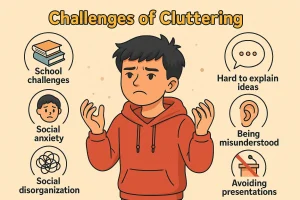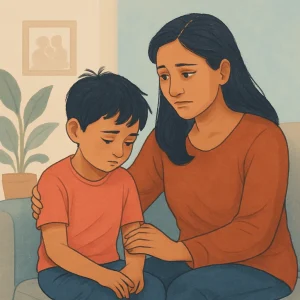5 Early Signs of Still Face Syndrome You Need to Know
Last Updated: October 1, 2024
“Is Your Baby Trying to Tell You Something?”
Early Signs of Still Face Syndrome: As parents or caregivers, we’re often attuned to our baby’s subtle cues. A smile, a frown, or even silence can speak volumes about their emotional state. However, it’s essential to recognize that some of these cues might be signaling deeper underlying issues. One such condition is Still Face Syndrome, a developmental phenomenon that can shed light on a baby’s emotional health.
In this article, we’ll delve into the early signs of Still Face Syndrome, helping you understand how to identify and address potential concerns. By being aware of these indicators, you can provide your baby with the necessary support and ensure their emotional well-being.
What is Still Face Syndrome?
When we think about bonding with a baby, what often comes to mind are those joyful moments of giggles, eye contact, and play. However, for babies who don’t receive these kinds of warm, emotional responses from their caregivers, a phenomenon known as Still Face Syndrome can occur.
Understanding Still Face Syndrome: A Quick Definition
Still Face Syndrome refers to the behaviors and reactions seen in a baby when their caregiver is emotionally unresponsive or “still.” It’s derived from the “Still Face Experiment,” which demonstrated that when a caregiver shows a blank, emotionless face, a baby quickly picks up on this lack of interaction. The baby may try different ways to engage—reaching out, smiling, or making sounds—but without a response, they can become distressed, withdrawn, or frustrated.
Babies naturally seek out interaction and connection from the faces around them. Think of the time you make silly faces to see your baby smile or the way they gaze into your eyes during feeding time. These back-and-forth exchanges are more than just fun; they’re essential building blocks for emotional and social development. When a baby faces a “still face” frequently, it can disrupt this natural bonding process.
The Key to Understanding: How It Impacts Emotional Growth and Bonding
Emotional growth in babies is like a two-way dance—it needs active participation from both sides. The constant exchange of facial expressions, vocal sounds, and movements helps the baby learn how to interact, bond, and respond to social cues. When these responses are missing or inconsistent, the baby can struggle with forming connections, learning to regulate their emotions, and developing a sense of safety and trust.
Imagine a baby trying to smile at their caregiver and receiving no response back. Over time, the baby might start to “shut down,” show fewer attempts to engage, or become more easily frustrated. These reactions are the early signs of Still Face Syndrome and indicate that the baby isn’t receiving the emotional “feedback” they need to flourish.
Early signs of Still Face Syndrome can manifest as a lack of eye contact, minimal emotional expression, or even fussiness when a caregiver isn’t responsive. By spotting these signs early and understanding how to actively engage with a child, parents and caregivers can take steps to support their child’s emotional development.
The 5 Must-Know Signs of Still Face Syndrome
When it comes to understanding early signs of Still Face Syndrome, it’s all about paying close attention to your baby’s responses and behavior. Babies communicate a lot, even without words, and these small signs can speak volumes about their emotional world. Let’s look at the five key signs to keep on your radar:
Signs vs. Typical Behaviors
| Typical Baby Behaviors | Signs of Still Face Syndrome |
| Makes eye contact with caregiver | Avoids eye contact or looks away |
| Babies usually seek eye contact, gazing at their caregivers’ faces as a way to connect and bond. | Babies with Still Face Syndrome may have difficulty maintaining or seeking eye contact, often looking away when trying to connect. |
| Smiles in response to a smile | Rarely or never smiles back |
| When a caregiver smiles at a baby, a typical response is for the baby to smile back, showing joy and emotional connection. | A baby may not respond with a smile, or their smiles may be rare or delayed, signaling difficulty in connecting emotionally. |
| Reacts to playful interaction | Shows little interest in games like peek-a-boo |
| Babies are often engaged and react to playful interactions such as peek-a-boo, waving, or playful sounds. They may giggle, laugh, or show excitement. | Lack of interest in playful interactions may indicate disengagement, where the baby appears uninterested or non-reactive to attempts at play. |
| Calms down when comforted | Becomes fussy or cries when ignored |
| When a baby is upset, they typically calm down when a caregiver holds, soothes, or comforts them with gentle touch and words. | Babies with signs of Still Face Syndrome may become fussy, distressed, or cry more easily when they don’t get a response, showing heightened sensitivity to unresponsiveness. |
| Engages actively | Withdraws or “zones out” when not responded to |
| Typical babies are curious and active participants in their environment, reaching out to explore and respond to stimuli. | If a baby seems to withdraw, become passive, or “zone out” frequently, it could be a sign they are struggling to engage due to lack of responsive interaction. |
1. Little or No Eye Contact
Ever notice how your baby locks eyes with you when they’re happy, curious, or seeking your attention? Eye contact is one of the most basic forms of connection between you and your baby. But if you observe that your little one rarely makes eye contact or avoids it altogether, it’s worth noting.
What to Look For: If your baby doesn’t maintain eye contact when you talk, sing, or play with them, it could be a sign that they’re struggling to engage emotionally.
Why It Matters: Babies naturally seek connection through their gaze. A lack of eye contact can be an early indicator of Still Face Syndrome, making it important to respond with warm, engaging expressions to encourage bonding.
2. Few Smiles or Joyful Reactions
Who doesn’t love a baby’s smile? That toothless grin is one of the most rewarding parts of parenthood. Babies typically respond to their caregivers’ happy faces and playful gestures by smiling back or showing joy. However, if those joyful expressions are few and far between, it might be more than just a “serious baby.”
What to Look For: Take note if your baby rarely smiles, doesn’t coo, or shows little to no reaction when you play peek-a-boo, make funny faces, or sing their favorite song.
Why It Matters: Babies naturally mirror their caregivers’ emotions. Limited or absent joyful reactions may signal they are not receiving or responding to emotional feedback, one of the red flags of Still Face Syndrome.
3. Unresponsive to Games and Play
Playtime is not just fun; it’s how your baby learns to interact with the world around them. Games like peek-a-boo, singing nursery rhymes, or even making silly noises usually get a reaction from babies. If your baby seems uninterested or doesn’t respond as expected during these playful moments, it might indicate they are struggling to engage.
What to Look For: Your baby doesn’t react to your efforts to play, laugh, or talk, and instead looks away, remains silent, or appears disinterested.
Why It Matters: Babies use play to bond and explore emotions. A lack of response to games or other playful activities could be a sign they’re not feeling emotionally connected, a key sign of Still Face Syndrome.
4. Frequent Fussiness When Ignored
Babies are naturally attention-seeking, and when they’re ignored, they might fuss, cry, or show signs of distress. But how much is too much? If you notice that your baby becomes unusually fussy, easily agitated, or cries often when you’re not giving them attention, it could be a sign they’re feeling emotionally disconnected.
What to Look For: Your baby frequently gets upset when you are not fully focused on them, even during short moments of distraction.
Why It Matters: While some fussiness is normal, constant distress or irritability when not engaged can be a response to feeling ignored or emotionally unsupported—both of which are common in babies showing early signs of Still Face Syndrome.
5. Going Quiet or Withdrawn
Babies are usually pretty vocal about their needs and emotions, whether through babbling, cooing, or simply making sounds. But if you notice that your baby becomes unusually quiet, appears withdrawn, or seems to “zone out” frequently, this could be a sign that they’re experiencing emotional disconnection.
What to Look For: Your baby tends to go silent, avoids eye contact, or looks away when you try to interact, as if they’re tuning out.
Why It Matters: Withdrawal or “shutting down” can be a coping mechanism for babies who don’t receive the emotional responses they crave. This passivity might indicate that they’re feeling disconnected, a potential red flag for Still Face Syndrome.
What Can You Do to Address Still Face Syndrome?
If you notice any of the early signs of Still Face Syndrome, don’t panic. There are many ways to connect more deeply with your baby and nurture their emotional development. Here’s how you can make a positive impact.
Connect and Engage to Prevent Still Face Syndrome
Babies love connection, and they thrive on face-to-face interactions. One of the best things you can do is be fully present when you’re with your baby. Hold them close, make eye contact, and let your facial expressions show warmth, joy, and love.
Simple Steps to Try:
- Make Eye Contact – When feeding or changing your baby, take those moments to gaze into their eyes. Even a few seconds of eye contact can create a strong sense of bonding.
- Speak and Sing Softly – Your voice is familiar and comforting. Speak to your baby often, narrate what you’re doing, or sing a lullaby. It helps them feel connected and safe.
Using Playful Interaction to Overcome Still Face Syndrome
Playtime is not just for fun—it’s essential for your baby’s social and emotional development. Use smiles, sounds, and playful gestures to keep your baby engaged. Even the simplest games can have a big impact.
Simple Steps to Try:
- Play Peek-a-Boo – A classic game for a reason! Babies love the surprise element and will often smile, laugh, or try to engage in response.
- Copycat Games – Mirror your baby’s sounds and movements. If they make a noise or wave their hand, do it back! This teaches them the basics of social interaction and emotional exchange.
- Tummy Time Chats – During tummy time, lay down face-to-face with your baby. Talk, smile, and encourage them to lift their head to see you. This not only strengthens their muscles but also builds emotional connection.
When to Seek Help for Still Face Syndrome
It’s completely normal to wonder whether your baby’s behaviors are part of their unique personality or something that may need extra support. If you’re concerned about any of the early signs of Still Face Syndrome, or if you’re unsure how to engage your baby emotionally, seeking advice is always a great step.
When to Seek Support:
- If your baby consistently shows signs of distress when you’re not engaging with them.
- If you notice persistent lack of eye contact or emotional response despite your efforts to connect.
- If you’re feeling overwhelmed and want guidance on how to best support your baby’s emotional health.
Conclusion
You’ve taken an important step in understanding Still Face Syndrome and how to recognize its early signs. Being aware of little cues like a lack of eye contact or limited emotional reactions can make a big difference in your baby’s development. Early detection is key, and it’s not about worrying but about being ready to support your baby’s needs. Spend face-to-face time, respond with smiles, and make play a priority. If you ever feel unsure or need guidance, don’t hesitate to reach out to a professional for support. Remember, small steps can lead to big changes in your baby’s emotional growth.
And don’t keep this knowledge to yourself! Share what you’ve learned with other parents, friends, and family. The more people who understand the early signs of Still Face Syndrome, the more support we can offer to babies and caregivers everywhere. If you’d like to know more about supporting your baby’s emotional development, check out WellnessHub for tips and resources. You’re doing an amazing job, and each step you take is helping your baby thrive.
Frequently Asked Questions:
1. What is Still Face Syndrome, and how does it affect babies?
Still Face Syndrome is a condition where babies show signs of emotional disconnection when they don’t receive responsive or engaging interactions from their caregivers. It can affect a baby’s social and emotional development, making them struggle with bonding and interaction.
2. What are the early signs of Still Face Syndrome in infants?
The early signs include a lack of eye contact, limited smiling or joyful expressions, unresponsiveness to play, frequent fussiness when ignored, and a tendency to become quiet or withdrawn. Recognizing these signs early can help provide the necessary support to the baby.
3. How can I help my baby if I notice signs of Still Face Syndrome?
If you notice any signs, focus on connecting more with your baby through eye contact, playful interactions, and gentle communication. Consistently engaging with your baby can support their emotional development. If concerns persist, consulting a pediatrician or child therapist is recommended.
4. When should I be concerned about my baby’s emotional responses?
While every baby is different, you may want to seek guidance if your baby rarely makes eye contact, shows limited emotional reactions, or often becomes distressed when you’re not engaging with them. Early intervention can help address any concerns effectively.
5. Can Still Face Syndrome affect my baby’s future development?
Yes, if left unaddressed, Still Face Syndrome can affect a baby’s emotional growth and social skills. Early detection and active engagement with your baby can support healthy development and reduce the impact on their future interactions and emotional well-being.
6. Is it normal for babies to avoid eye contact sometimes?
It can be normal for babies to occasionally avoid eye contact, especially when tired or overwhelmed. However, if you notice a consistent lack of eye contact along with other signs of Still Face Syndrome, it’s helpful to seek advice to better support your baby’s needs.
7. How can play help in preventing Still Face Syndrome?
Play is a crucial way for babies to learn about emotional exchanges and connect with their caregivers. Games like peek-a-boo, copying sounds, and singing can enhance bonding and support your baby’s emotional development, reducing the risks associated with Still Face Syndrome.
8. How often should I engage with my baby to prevent signs of Still Face Syndrome?
Regular daily interaction is key to fostering your baby’s emotional growth. There’s no set amount of time, but make sure to have moments of face-to-face play, eye contact, and responsive communication throughout the day. These consistent connections can help prevent signs of Still Face Syndrome.
9. Can Still Face Syndrome be related to other developmental issues?
While Still Face Syndrome specifically relates to emotional engagement, it can sometimes coincide with other developmental concerns like speech delays or social skill difficulties. However, early intervention focused on connecting and engaging with your baby can address emotional responses and support overall development.
10. Is professional support necessary for mild signs of Still Face Syndrome?
If the signs are mild and you notice improvements with more interaction, professional support might not be necessary right away. However, if the signs persist or you’re unsure how to support your baby best, consulting a pediatrician or child development expert can provide peace of mind and helpful guidance.
About Author:
Lasya Vooturi,
Clinical Psychologist (A) & Behavioral Therapist
Lasya holds a Professional Diploma in Clinical Psychology from Amity University, where she deepened her understanding of psychological principles from March 2023 to March 2024. With over a year of dedicated experience as a Behavioral Therapist, Lasya has honed her skills in applying effective therapy techniques tailored to individual needs. Fluent in Telugu, Hindi, and English, she is adept at connecting with a diverse range of clients, ensuring comprehensive communication and understanding. Lasya’s approach is grounded in empathy and scientific rigor, making her a trusted ally in navigating mental health challenges.
Book your Free Consultation Today
Parent/Caregiver Info:
Client’s Details:
* Error Message









